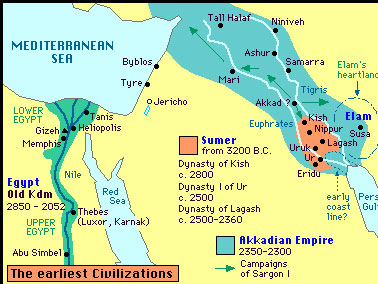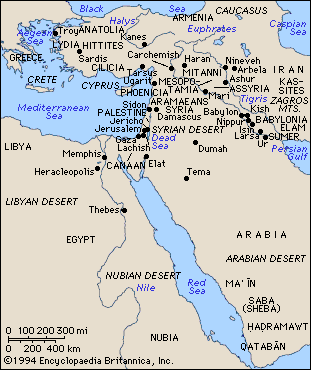 Many bone sickle handles and flint sickle edges dating from between c. 9000 and 7000 B.C. have been found in Palestinian sites.
Many bone sickle handles and flint sickle edges dating from between c. 9000 and 7000 B.C. have been found in Palestinian sites.The Ancient Middle East
The high antiquity of civilization in the Middle East is largely due to the existence of convenient land bridges and easy sea lanes passable in summer or winter, in dry or wet seasons. Movement of large numbers of people north of the Caspian Sea was virtually impossible in winter, owing to the severity of the climate; central Eurasia was often too dry in summer. Land passage between Asia and Africa was in early times limited to narrow strips of land in the Isthmus of Suez. Large-scale desert travel was limited to special routes in Iran and in North Africa, both east and west of the Nile Valley.
Another reason for the early significance of this area in world history is the fact that the water supply and the climate were ideal for the introduction of agriculture. Several species of grain grew wild, and there were marshes and tributary streams that could easily be drained or dammed in order to sow wild wheat and barley. The seed had only to be strewn over a sufficiently moist surface to ensure some kind of crop under normal conditions. It is therefore not surprising that there is evidence of simple agriculture as far back as the 8th or 9th millennium B.C., especially in Palestine, where more excavating has been done in early sites than in any other country of the Middle East. Many bone sickle handles and flint sickle edges dating from between c. 9000 and 7000 B.C. have been found in Palestinian sites.
Many bone sickle handles and flint sickle edges dating from between c. 9000 and 7000 B.C. have been found in Palestinian sites.
In Mesopotamia and Iran remains of this period appear in caves on the lower slopes of the Zagros Mountains between western Iran and Iraq. The date of the systematic introduction of irrigation on a large scale in Mesopotamia is somewhat doubtful because most of the early sites of irrigation culture were covered long ago by accumulation of alluvial soil brought down by the spring floods of the Tigris and Euphrates rivers. Archaeologists once thought that all irrigation originated in the foothills of the Zagros and that the earliest true farmers lived in the plains of Iran. But recent excavations and surface explorations have proved that irrigation around the upper Tigris and Euphrates, as well as their tributaries, dates from the early 6th millennium B.C. (e.g., at al-Kawm on the Upper Euphrates). Small-scale irrigation was practiced in Palestine (e.g., at Jericho) in the 7th millennium B.C.
In northern and eastern Mesopotamia, main streams were soon partly diverted during moderate river floods into canals running more or less parallel to the rivers, which could thus be used to irrigate an extensive area. Such deflector dam irrigation avoided the self-destructive weaknesses of large storage dams, in particular the danger of depositing great masses of refractory mud in the storage basin behind the dam. In the north and east considerable urban installations developed at sites such as Nineveh no later than the 5th millennium B.C., when southern Mesopotamia was still mostly swampland like the early Egyptian delta. The Euphrates had a much smaller flow of water than the nearby Tigris. The latter was much swifter, however, so that it was potentially more important for irrigation, even though much harder to tame.
The Egyptian Nile had a much more predictable water flow than the Mesopotamian rivers because it flowed through hundreds of miles of swamp, where unusually high annual floods spread out, interfering with navigation but averting the danger of the occasional destructive inundations of Mesopotamia.
Mesopotamia and Egypt to c. 1600 B.C.
The oldest known urban and literate culture in the world was developed by the Sumerians in Mesopotamia beginning in the late 4th millennium B.C. About 2300 B.C. a Semitic leader, Sargon I, conquered all of Babylonia and founded the first dynasty of Akkad (Akkadu), which held power for about a century and a half. Sargon and his successors were the first known rulers in southwestern Asia to gain control of the Fertile Crescent as well as of adjacent territories. They sent trading expeditions to central Anatolia and Iran and as far as India and Egypt. After the fall of the dynasty of Akkad there was a Sumerian revival under the 3rd dynasty of Ur (Ur III [21st-20th centuries]), followed by another influx of Semites. These people founded the first dynasty of Babylon (19th-16th centuries), whose most important king was Hammurabi. In the 17th century new ethnic groups appeared in both Babylonia and Syria-Palestine: Kassites from the Zagros Mountains, Hurrians from what is now Armenia, and Indo-Europeans from Central Asia. This period marked the end of the formative phase of Mesopotamian civilization. 
Shortly after 3000 B.C. the numerous small states that had arisen in the Nile Valley during the 4th millennium were united under the 1st dynasty of Egypt. At this time the Egyptians had already developed a system of writing. Between c. 2686 and c. 2160 B.C. their country was united under a powerful monarchy (the Old Kingdom) served by a complex bureaucracy.
Toward the end of the 3rd millennium there was a period of disunity, followed by reunification under the 12th dynasty (1991-1786).
During these two centuries Egyptian control was established over Nubia, Libya, Palestine, and southern Syria. Soon after 1800 B.C. the Egyptian Empire fell apart, and c. 1700 Egypt was overwhelmed by the Asian "Hyksos," who ruled the country for a century and a half.
New states and peoples
Before the close of the 16th century B.C. the native 18th dynasty rose in Egypt; it expelled the Hyksos and founded the New Kingdom. The New Kingdom rulers moved back into Syria-Palestine and came into conflict first with the Hurrian state of Mitanni and later with the Anatolian Hittites, who were expanding into Syria from the north in the 14th century B.C. The Amarna Letters (diplomatic correspondence written in Babylonian script and language and discovered in Egypt by archaeologists) are an important source of information on this period. In Mesopotamia the dominant powers were Kassite Babylonia and Assyria (which emerged from subjection to Mitanni in the early 14th century B.C.). Relations between states were governed by elaborate treaties, which were constantly being broken. After the fall of Mitanni (c. 1350) the Hittites and Babylonians both directed their hostility against Assyria. Kassite Babylonia was subjugated by Assyria c. 1230. This, followed by the fall of the Hittite Empire (c. 1200), ended what has been called the first "International Age" in the civilized world.
The latter part of the 13th century B.C. saw the irruption of new peoples into the Aegean, Anatolia, and the Fertile Crescent; their appearance coincided with the Trojan War, the collapse of the Hittite Empire, and the destruction of many coastal cities of Greece, Cyprus, and Syria-Palestine. Best known of the new settlers from the west are the Phrygians, who occupied most of the old Hittite heartland, and the Philistines, who moved into Palestine.
At the same time, in Transjordan and western Palestine, the Hebrews founded a tribal confederation that was changed into a monarchy by Saul and David (c. 1020-960 B.C.).
In the east the Iranian tribes, led by the Medes, were pouring into Iran from Turkistan. From the south and west came the Semitic Aramaeans. The Aramaeans and Medes were to transform the ancient Middle East.
The Assyrian state suffered an eclipse in the 11th century B.C., when the Aramaeans and related tribes occupied most of its territory. It was not until the late 10th century that the Assyrians began to recover, but by 850 they had conquered much of western Media and southern Armenia as well as Babylonia and Syria. In the following centuries, until just before 630, the empire was greatly expanded. It was also highly organized administratively; its language became Aramaic.
The Canaanite Phoenicians on the Syrian coast re-established their trading communities after the Philistine and Aramaean invasions; in the 10th and 9th centuries they moved out into the Mediterranean, establishing colonies in North Africa and as far west as Spain. Their influence in the western Mediterranean declined after the 6th century. Their Carthaginian colony then took over Phoenician trade in the western and central Mediterranean.
Farther east the Medes and Chaldeans destroyed the Assyrian Empire at the end of the 7th century. The Chaldean dynasty in Babylonia carried on Assyrian traditions of administration and encouraged commerce; under Nebuchadrezzar II (c. 605-c. 561 B.C.) their Neo-Babylonian Empire became the most powerful political entity of its time. Its rule extended from the Taurus Mountains in Anatolia to eastern Arabia and deep into southern Iran. This short-lived state made a tremendous impression on contemporaries, especially on the Jews, whose state was destroyed and who were carried into the Babylonian Captivity, and on the Greeks, to whom the glory of Babylon became legendary.
The Achaemenian Empire and its successors
In the 6th century the Iranian Persians under Cyrus the Great conquered their Median cousins and established the Achaemenian state (549). This was followed by the conquest of Lydia (546) and the Babylonian Empire (539). Aramaic became the official language of the Persian Empire, and its official religion was Zoroastrianism. Cyrus' enlightened policy put an end to the Assyro-Babylonian practice of deporting conquered peoples and trying to destroy all local nationalisms.
At its height the Achaemenian Empire ruled the whole of the Middle East; Greek resistance prevented it from expanding successfully into Europe.
In 334 B.C. Alexander of Macedon invaded Anatolia and nine years later completed the conquest of the Persian realm. His vast empire was broken up into Macedonian "successor states" after his death. The Seleucid kings of Syria controlled most of Anatolia, Mesopotamia, and Iran. About 250 B.C. the still seminomadic Parthians emerged from a small area southeast of the Caspian Sea. Establishing control over Iran, they declared their independence of the Seleucid Empire and in the 2nd century B.C. expanded westward into Mesopotamia. In the 3rd century AD the semi-Hellenized Parthians were replaced by the Persian Sasanians. The Sasanians ruled Iran from AD 224 to 642; they extended its boundaries, reinvigorated its administration and cultural life, and challenged Roman power in the Middle East. In 636 the Sasanian Empire was conquered by the Muslim Arabs, bringing to an end the last phase of ancient Middle Eastern civilization. (Encyclopaedia Britannica Article)